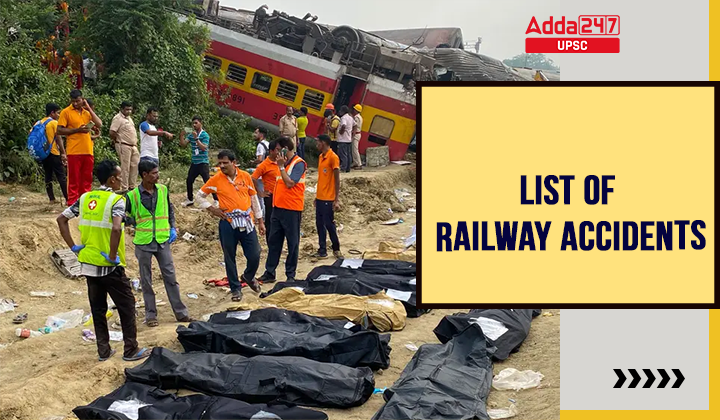Table of Contents
Railway Accidents in India
Railway accidents in India have been a significant concern for decades. The country boasts one of the world’s largest and busiest railway networks, carrying millions of passengers and tons of cargo daily. However, this extensive infrastructure also comes with its fair share of challenges. Accidents, including derailments, collisions, and fires, have tragically claimed many lives and caused substantial damage to property.
Factors contributing to these incidents include overcrowding, aging infrastructure, human error, and maintenance issues. Efforts have been made to enhance safety measures, invest in modern technology, and improve rail maintenance practices, but the challenge remains complex due to the sheer scale of the system. Continued vigilance and proactive steps are essential to mitigate railway accidents and ensure the safety of passengers and personnel.
Recent Train Accidents in India 2023
There have been a number of train accidents in India in 2023, including:
- June 2: Three trains collided in Balasore district, Odisha, killing 296 people and injuring more than 1,000 others.
- August 26: A fire broke out in a stationary train compartment at Madurai railway station, Tamil Nadu, killing 9 people and injuring 20 others.
- October 11: Six coaches of the North East Express derailed near Raghunathpur Railway Station in Buxar district of Bihar, killing 4 people and injuring more than 70 others.
- The causes of these accidents are still under investigation, but they are likely due to a combination of factors, including human error, poor track maintenance, and defective equipment. The Indian government has taken a number of steps to improve railway safety in recent years, but more needs to be done to prevent these tragedies from happening.
- In addition to the above, there have been a number of other minor train accidents in India in 2023, resulting in injuries and property damage. It is important to note that the Indian Railways is a vast network, carrying over 22 million passengers per day. Despite the number of accidents, the Indian Railways remains a relatively safe mode of transportation. However, the government and the Railways must continue to work to improve safety and reduce the risk of accidents.
List of Railway Accidents in India
- India has the world’s fourth-largest railway network, and as such, it is prone to railway accidents. The most common types of railway accidents in India are derailments, collisions, and level-crossing accidents.
- According to the Indian Railways, there were 121 railway accidents in India in 2021-22, resulting in the deaths of 655 people and injuries to 1,808 others. This is a significant decrease from the previous year when there were 147 accidents resulting in 1,227 deaths and 2,991 injuries.
- The deadliest railway accident in Indian history occurred on June 6, 1981, when a train derailed while crossing a bridge in eastern Bihar and plunged into the river below. More than 800 people were killed in the accident.
Major Railway Accidents in India include:
- 1995 Firozabad rail disaster (358 killed)
- 2023 Odisha train collision (296 killed)
- 1999 Gaisal train disaster (285 killed)
- 1998 Khanna rail disaster (212 killed)
- 2002 Rafiganj train wreck (200 killed)
- 1964 Rameswaram cyclone causing Pamban Bridge accident (150+ killed)
- 2010 Jnaneswari Express train derailment (148 killed)
The Indian government has taken a number of steps to improve railway safety in recent years, including investing in new infrastructure, improving track maintenance, and upgrading signaling systems. However, more needs to be done to reduce the number of railway accidents in India.
Railway Accidents in India Statics
- According to the Indian Railways, there were 121 railway accidents in India in 2021-22, resulting in the deaths of 655 people and injuries to 1,808 others. This is a significant decrease from the previous year, when there were 147 accidents resulting in 1,227 deaths and 2,991 injuries.
- The number of railway accidents has been declining in recent years, but they remain a major problem in India. The Indian Railways is the fourth-largest railway network in the world, and it carries over 22 million passengers per day.
- The most common types of railway accidents in India are derailments, collisions, and level-crossing accidents. Derailments occur when a train derails from the tracks. Collisions occur when two trains collide with each other. Level-crossing accidents occur when a train collides with a vehicle or person at a level crossing.
Here are some statistics on railway accidents in India:
In 2021-22, there were 121 railway accidents in India, resulting in the deaths of 655 people and injuries to 1,808 others.
The number of railway accidents has been declining in recent years, but they remain a major problem in India.
The most common types of railway accidents in India are derailments, collisions, and level-crossing accidents.
Human error is the leading cause of railway accidents in India.
The Indian government has taken a number of steps to improve railway safety in recent years, but more needs to be done to reduce the number of railway accidents in India.
Railway Accidents Causes and Safty Measures
Check here the causes and safety measures for Railway Accidents:
Causes
- Infrastructure Problems: The railway system, which includes things like tracks, bridges, wires, and trains, often has issues because it’s not properly maintained, getting old, sometimes damaged on purpose, or due to natural disasters. A lot of these parts were built a long time ago and haven’t been updated to keep up with the increasing number of people using trains and modern safety standards. Plus, the railway system doesn’t always have enough money, and there can be problems like corruption and inefficiency that make it hard to improve.
- Mistakes by People: The folks who work on the railways, responsible for running the trains and keeping everything safe, can sometimes make mistakes. This happens because they might be tired, not paying attention, doing the wrong thing on purpose, or not following safety rules. These mistakes can lead to things like the wrong signals, communication problems, speeding, or missing things that are broken or dangerous. Also, these railway workers might not always have the right training or communication skills, which makes their jobs harder.
- Signal Troubles: The signals, which tell trains where to go and when to stop, can sometimes mess up. This can be because of technical problems, losing power, or mistakes made by people. When signals don’t work right, it can lead to trains going the wrong way, crashing into other trains or things that aren’t supposed to move, or missing their stops. For example, a recent train accident in Odisha happened because a change in the signal system wasn’t properly told to the train drivers.
- Dangerous Crossings: Some places where roads cross railway tracks don’t have any gates or signals to control traffic. These are called unmanned level crossings (UMLCs), and they can be really risky because cars or people might not notice a train coming or might try to cross when a train is very close. In the past, these crossings were the cause of 16% of all train accidents in India. While the railways have fixed this problem on some routes, there are still many places where manned level crossings (MLCs) exist, and these can also be risky.
Safety Measures
- Railway Safety Fund (RRSK): This is a special fund created in 2017-18 with a big pile of money (Rs 1 lakh crore) that’s meant to be used over five years to make important safety improvements in the railways. These improvements include things like fixing and renewing tracks, upgrading signals, and rehabilitating bridges.
- Better Train Technology: The trains themselves are getting an upgrade. They now have improved designs and features, like special couplers, better brakes, and a system that detects fires and smoke in the train cars. There’s also a new safety system called KAVACH to protect the trains.
- New Coaches: The passenger train cars are being replaced with lighter and safer ones. These new coaches are based on technology from Germany and have features to prevent things like climbing accidents, they’re fire-resistant, can go faster, and last longer than the old ones.
- Fog Navigation Device: A handy device that helps train drivers to see through the fog. It’s like a GPS for trains and tells the driver how far away things like signals and road crossings are, and it makes loud noises when they get close to these things.
- Stronger Tracks and Bridges: The tracks and bridges are getting stronger and more durable. They’re using fancy concrete sleepers and tougher rails, among other things, to make sure the trains run smoothly and safely.
- Detecting Faulty Tracks: There’s a smart way to find and fix bad rails. It uses sound waves to check if the rails have cracks or problems that could make a train go off track. When they find a bad rail, they replace it.
- Automatic Track Maintenance: They’re using machines to do track maintenance work, like packing down the gravel and keeping the tracks in good shape. This makes the tracks safer and reduces mistakes made by people.
- Central Control System: They have a system that lets them control switches and signals from one central place instead of having people do it manually. This reduces the chances of mistakes and makes the railways safer.
- Getting Rid of Dangerous Crossings: They’re working to eliminate places where roads and railways cross without any barriers or signals. They’re either closing them, making them safe, or putting bridges and tunnels to keep people and vehicles separate from the trains.
Prevention of Railway Accidents
- Spend More on Safety: Put more money into fixing and upgrading things like tracks, bridges, signals, and train cars to make them safer.
- Train Workers Better: Teach railway staff about the latest technology, equipment, safety rules, and procedures to reduce mistakes.
- Get Rid of Dangerous Crossings: Replace the risky road and railway crossings with bridges or tunnels to separate trains and vehicles.
- Use High-Tech Safety Gear: Install advanced safety devices like anti-collision systems to prevent accidents. These need to be set up all over the railway network.
- Reward Good Performance: Give railway staff incentives based on how well they follow safety rules and do their jobs.
- Delegate Non-Core Tasks: Let other companies or government bodies take care of things like hospitals and colleges to make the railway system more efficient and cheaper to run.
- Create a Safety Authority: Set up a new group with legal powers to make safety rules, do safety checks, hold people accountable for mistakes, and investigate accidents.
- Regular Safety Checks: Keep an eye on how safe the railway staff, equipment, and infrastructure are, and punish those who don’t follow the safety rules.
- Improve Communication: Make sure all the different parts of the railway system talk to each other and work together better.
- Encourage Reporting: Create a system where all staff can report safety problems without fear of punishment, using technology to make it easy and private.
- Change the Attitude: Instead of blaming and punishing, focus on everyone working together to keep things safe.
- Rethink Worker Scheme: Take a good look at the worker program and how it affects loyalty, ownership, and safety. Consider changing it to encourage specialization and dedication to safety.
| Articles Related to Railways | |
| Amrit Bharat Station Scheme | Railway Accident in India |
| Editorial Analysis | CAG Report on Indian Railways |



 TSPSC Group 1 Question Paper 2024, Downl...
TSPSC Group 1 Question Paper 2024, Downl...
 TSPSC Group 1 Answer key 2024 Out, Downl...
TSPSC Group 1 Answer key 2024 Out, Downl...
 UPSC Prelims 2024 Question Paper, Downlo...
UPSC Prelims 2024 Question Paper, Downlo...
